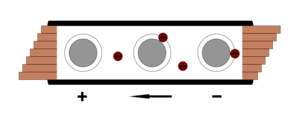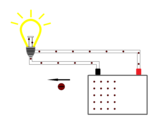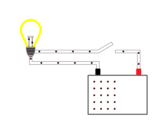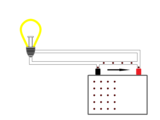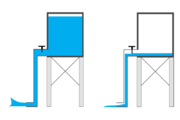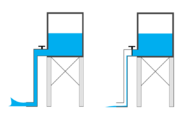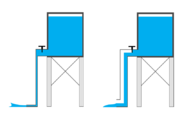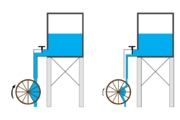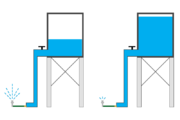Electricity and energy
Electricity seems to be everwhere: flowing in our bodies to power our hearts, lightning is constantly striking the earth at roughly 100 strikes per second[1], and nearly all of the factories and offices in the world use it. But it only seems to be everwhere as there continue to be nearly a billion people without access to electricity globally, primarily rural villages. The primary issue has always been that electricity was always produced in a few select locations and then distributed out from there in a system called the electrical grid to homes and businesses, which can be very expensive to expand. Despite not even reaching everyone on the planet, the electrical grid causes significant environmental damage that affect everyone.
PV systems can be used to solve both of these issue: a lack of access in many parts of the world and the pollution that is created by non-renewable forms of energy like coal. Grid-tied PV systems can be used to help reduce the environmental impacts of electricity use and stand-alone PV systems can help provide energy to areas where the grid doesn’t reach as they are able to produce, store and provide energy in the form of electricity even in the most remote locations.
A PV system needs to be designed to match the characteristics of the electrical system in an area and the energy needs of the end-user. Not just designers and installers of off-grid systems need to understand electricity and energy thoroughly, but also users to make sure that they do not damage their system by using it beyond its capabilities. The main concepts that are necessary to understand are:
- Current
- Voltage
- Resistance
These are the building blocks of even the most complex electrical systems.
Contents
What is electricity?
Electricity is a force created from the basic building block of all matter - atoms. All atoms are composed of three core components - neutrons (no charge), protons (positive charge) and electrons (negative charge). Out of these three, the only one that is able to freely move from atom to atom is the negatively charged electron. Electrons can build up in higher concentrations in some locations and create a negative charge. Or there can be a lack of electrons, which create a positive charge. Electrons desire to flow from areas of high electron concentration to areas of low electron concentration. Not all atoms or materials have free electrons that can move around easily such as wood, plastic or rock. We call these insulators. Metals and copper are good conductors as they have abundant free electrons.
The small static electric shocks that we receive from our cloths are the result of a difference in electrons from your body to that item - this difference is voltage. As the electrons pass from your body to that item of clothing a current is created.
Circuits
Static electricity and lightning are not useful to humanity as they are not in controlled systems. Electricity needs to be contained within an electrical system comprised of circuits for it to be used properly and safely. A basic electrical circuit is a closed loop built out of the following: 1. An energy source that has or can create an imbalance of electrons between to two points, which is voltage. 2. Conductive material, like wires, that allows electrons to flow from areas of high concentration to areas of low concentration. This flow is current. 3. A load or some means of constraining electron flow. Without a load or some kind of way of restraining electron flow, the electron difference created by the energy source will quickly reach zero.
Circuits can be in various states:
- Closed: Connected, on, functioning. A properly connected circuit with a load which has current flowing.
- Open: Disconnected, off, disabled. A circuit that is not connected or switched off which has no current flowing.
- Short: Fault, improper low resistance connection. A circuit that has been improperly built without sufficient resistance - like a load - to constrain the flow of current. A circuit in a short circuit state will allow as much current to flow as possible until the power source is exhausted. If a load is connected in parallel with a short-circuit, like in the diagram, the load may stop functioning due to insufficient voltage/current.
Characteristics of electricity
Electricity is almost always invisible, but we can use something that acts similarly - water - to make the concept understandable. A circuit with a battery - like in the previous graphic - operates at a certain voltage and current, similarly a basic system used to transport and store water operates with a certain pressure and volume.
- The voltage an electrical circuit is similar to the pressure in a water system.
- The current an electrical circuit is similar to the flow in a water system.
- The wires and load in an electrical circuit create resistance. The pipes and devices that consume water, like a sprinkler, also create friction.
Voltage
Voltage is the force that moves electrons in a circuit and is measured in volts (V). It can be thought of as electrical pressure and in a circuit with a battery the voltage is determined by type of battery and the amount of energy stored in the battery. Voltage is similar to the pressure created in the water system. It depends upon the amount of water in the water that it holds.
Current
Current is the flow of electrons in a circuit and is measured in amperes or amps (A). Current is similar to the volume of water flowing in the water system. It depends upon the amount of water permitted to flow by the valve and upon the pressure in the system.
Resistance
Resistance (R) is a force that resists the flow of current, which is present in all materials and all electrical systems. It is measured in Ohms (Ω). If the wires in an electrical circuit are too small for the amount of current that they need to carry, it will create friction and heat. Voltage is lost as a result. Similarly, the pipes through which the water flows in the water system can create friction if there is too much pressure or volume trying to pass through them.
Power: watts
Power (P) is a measurement of work done in a unit of time. How much electricity is being consumed, which is power, in an electric circuit depends upon both the voltage and the current of the circuit. In electrical systems power is measured in watts (W) A watt is a measure of the energy produced or consumed in one second. Power is also commonly expressed in kW (1 kW = 1000 W) and MW (1 MW = 1,000,000 W) in larger systems. Similarly, if water flowing from the water system is used to perform work, like spinning a wheel, the power that is used will depend upon both the volume and the pressure of the water supplied. An inefficient load in an electrical system or water system requires more power to function than an efficient one.
The formula for calculating power in an electrical system is:
| Power (P) | = voltage (V) × current (I) |
|---|
The same amount of power can be generated with by using varying amounts of voltage and current. For example:
- 1000 watts = 10 volts × 100 amps
- 1000 watts = 100 volts × 10 amps
[[File:Phonecharger.png|thumb|right|All appliances should have a label with their rated power consumption on them. Often times it is in volts and amps rather than watts. With these two values, you can easily calculate the power (W) for the load.
The equation can also be rearranged to solve for missing variables. If you have any two of the three variables (P, V, I), then you can solve for the third. For example:
Example 1: A cell phone is charging. It is connected to a 12 V battery and there is .5 A of current flowing. How much power is being consumed?
- P = 12 V × .5 A
- W = 6 W
Example 2: A television is using 48 W of power. The battery that it is connected to has a voltage of 12 V. How much current (I) is flowing?
- 48 W = 12 V x I
- I = 48 W ÷ 12 V
- I = 4 A
Example 3: A small water pump is being used to fill a tank. It is a 440 W pump and there are 2 A of current flowing. What is the voltage of the system?
- 440 W = V × 2 A
- V = 440 W ÷ 2 A
- V = 220 V
Energy: watt-hours
Power is a quick look at how much energy is being consumed or produced. For an electrical system this is an important value, but it is equally important to understand power consumption over time. Energy consumption over time is measured in watt-hours (Wh) or kilo-watt-hours (kWh). A watt-hour is the consumption of 1W of power for 1 hour. The formula for calculating Watt-hours is simple:
| Watt-hours (Wh) | = power (P) × time in hours (t) |
|---|
- Time in hours can be a fraction or percentage if necessary.
Example 1: A radio is plugged in and plays music for 3 hours. The radio says on the back that it consumes 7 W of power.
- Wh = 7 W × 3 hours
- Wh = 21 Wh
Example 2: The motor on a fan says that it requires 60 W. The fan is left on during the night for 12 hours.
- Wh = 60 W × 12 hours
- Wh = 720 Wh
Notes
- ↑ NOAA Lightning Flash Rate. https://sos.noaa.gov/datasets/lightning-flash-rate/

